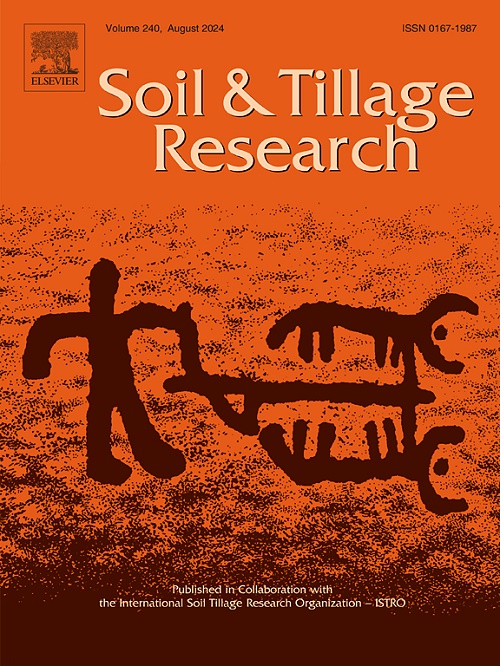皮沙砂岩添加物对中国木乌沙地沙质土壤微结构稳定性的影响
IF 6.8
1区 农林科学
Q1 SOIL SCIENCE
引用次数: 0
摘要
沙区土壤结构的退化破坏了土壤的功能,对环境的可持续性构成了重大威胁。天然土壤改良剂皮沙砂岩的掺入是减少毛乌素沙地水土流失、扩大耕地面积的有效干预措施。然而,对皮沙砂岩与砂质土混合形成的改良砂质土的微观结构稳定性和回弹性的认识还不够充分。本研究旨在评价加砂对砂土细观结构稳定性的影响。测试了4种修正率(16.7 %、33.3 %、50 %、100 % w/w)和5种含水率(40 % ~ 80 %)。通过流变仪进行振幅扫描和旋转剪切测试,评估了与微观结构稳定性和结构弹性相关的关键参数。结果表明:土的抗剪能力(τLVR、τmax、τy)、库容模量(G’yp)和黏度(η0)随着砂体的加入而降低,这与砂体的润滑作用和膨胀特性有关。此外,在低扰动条件下,Pisha砂岩增强了砂质土的物理弹性(γLVR)和结构恢复。而当含水率超过50% %时,掺加比沙砂岩后,修正砂质土的流动性增大。当沙石添加量为16.7 %时,砂质土的结构弹性、抗剪性和刚度最佳。这些研究结果为利用Pisha砂岩提高沙质土结构稳定性提供了有价值的见解,为完善改良比例和改进农业管理实践提供了科学依据。本文章由计算机程序翻译,如有差异,请以英文原文为准。
Effects of Pisha sandstone additions on microstructural stability of sandy soil in Mu Us Sandy Land, China
The degradation of soil structure in sandy regions undermines soil functionality and poses a significant threat to environmental sustainability. The incorporation of Pisha sandstone, a natural soil amendment, has been recognized as an effective intervention to reduce soil erosion and expand arable land in the Mu Us Sandy Land, China. However, the microstructural stability and resilience of amended sandy soil formed by mixing Pisha sandstone with sandy soils remain inadequately understood. This study aims to evaluate the effects of Pisha sandstone addition on the microstructural stability of sandy soils. Four amendment rates of Pisha sandstone (16.7 %, 33.3 %, 50 %, and 100 % w/w) and five water content levels (40 %-80 %) were tested. Key parameters related to microstructural stability and structural resilience were assessed using amplitude sweep and rotational shear tests via a rheometer. Results indicated that soil shear resistance (τLVR, τmax, τy), storage modulus (G'YP) and viscosity (η0) decreased with the addition of Pisha sandstone, attributed to its lubricating effect and swelling properties. Additionally, Pisha sandstone enhanced physical elasticity (γLVR) and structural recovery of sandy soil under conditions of low disturbance. However, when water content exceeded 50 %, the fluidity of the amended sandy soil increased with Pisha sandstone addition. The sandy soil with a Pisha sandstone addition rate of 16.7 % exhibited optimal structural elasticity, shear resistance, and stiffness. These findings provide valuable insights into the enhancement of sandy soil structural stability using Pisha sandstone, offering a scientific foundation for refining amendment ratios and advancing agricultural management practices.
求助全文
通过发布文献求助,成功后即可免费获取论文全文。
去求助
来源期刊

Soil & Tillage Research
农林科学-土壤科学
CiteScore
13.00
自引率
6.20%
发文量
266
审稿时长
5 months
期刊介绍:
Soil & Tillage Research examines the physical, chemical and biological changes in the soil caused by tillage and field traffic. Manuscripts will be considered on aspects of soil science, physics, technology, mechanization and applied engineering for a sustainable balance among productivity, environmental quality and profitability. The following are examples of suitable topics within the scope of the journal of Soil and Tillage Research:
The agricultural and biosystems engineering associated with tillage (including no-tillage, reduced-tillage and direct drilling), irrigation and drainage, crops and crop rotations, fertilization, rehabilitation of mine spoils and processes used to modify soils. Soil change effects on establishment and yield of crops, growth of plants and roots, structure and erosion of soil, cycling of carbon and nutrients, greenhouse gas emissions, leaching, runoff and other processes that affect environmental quality. Characterization or modeling of tillage and field traffic responses, soil, climate, or topographic effects, soil deformation processes, tillage tools, traction devices, energy requirements, economics, surface and subsurface water quality effects, tillage effects on weed, pest and disease control, and their interactions.
 求助内容:
求助内容: 应助结果提醒方式:
应助结果提醒方式:


